How to Build Blog Traffic
Blogging SEO StrategyI’ve been going through a massive blog post purge and deciding which posts to keep or trash. Why? I have so many posts that were like Tweets, short and meaningless. They just bogged down my performance and really provided my readers with zero information.
This blog started dying at the beginning of 2020, Google made some Search Engine Results Page (SERP) changes and my blog started dropping like a rock. There were 100’s of similar blogs that were ranking better because they knew how to play the SEO game and I didn’t. So I decided to put a stop to it.
I made some drastic changes to how I generate and build this blog, notably I started using Hugo and tweaking it for SEO purposes. I’m happy to say that my long slide on SEO oblivion has stopped and my Organic searches are back to January 2020 levels. I still have a long way to go but all the work I put into rebuilding this blog is starting to pay off.
Another big change I’ve done is to consolidate my old RapidMiner tutorials into one page. Over time I plan on writing detailed explanations to all my videos as a ’notes page,’ something to help my readers. The moral of the story is that for blogs to stay relevant these days you have to build them in knowledge repositories. Gone are the wild west days of when Blogger was still relevant and everyone posted about their weekend, that’s for Instagram now.
What’s not surprising is that my readers come from all over the world. The map below are where they came from in the first half of 2016. The majority of them came from the USA, followed by Europe, and then Asia. This does not come as a surprise and makes complete sense because the users were searching for RapidMiner Tutorials.
Below is my SEO strategy from the first half of 2016. I plan to update this to make it evergreen content for SEO, but for now I collapsed 4 posts into 1. I plan on collapsing some of my blog building traffic tutorials into one updated post too
The ironic thing? My blog activity hasn’t changed from 2016 to 2020 and that’s plain terrible. I’m either writing too thin content or something that’s not interesting for my readers. It might just be both.
SEO from 2016
I took a look at my Google Analytics data from the start of 2016 through June 30th 2016. It’s easy to see that my engagement is dwindling away.

When I actually add a trend line, I can confirm that the trend is down.
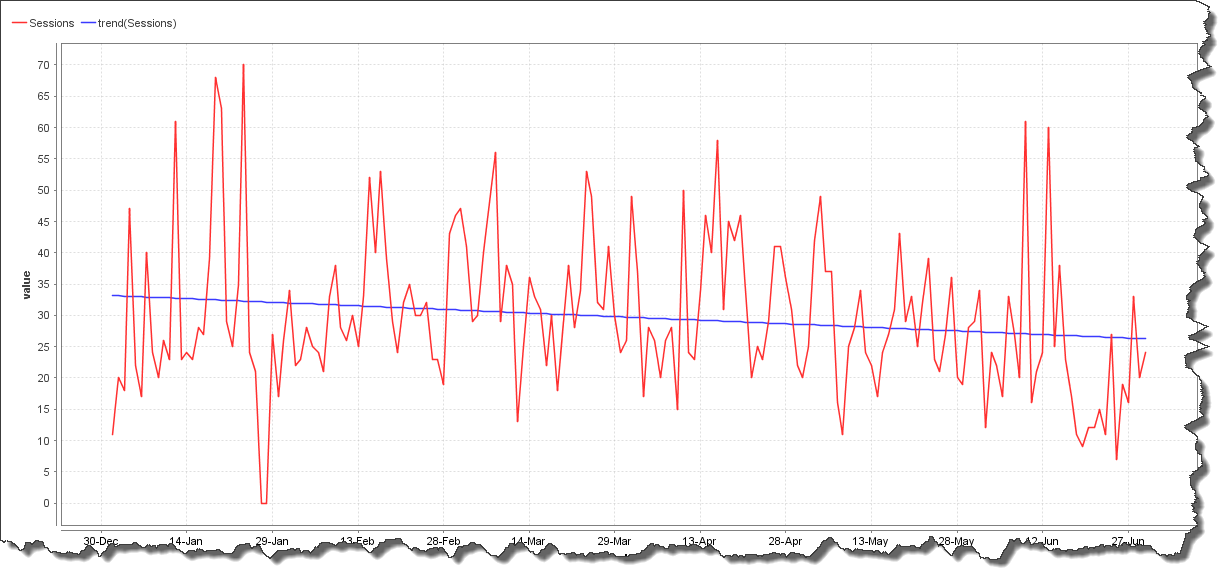
Further, If I look at the most popular blog posts it’s easy to see that it’s my RapidMiner Tutorials (milkshake) that brings all the readers to the yard.
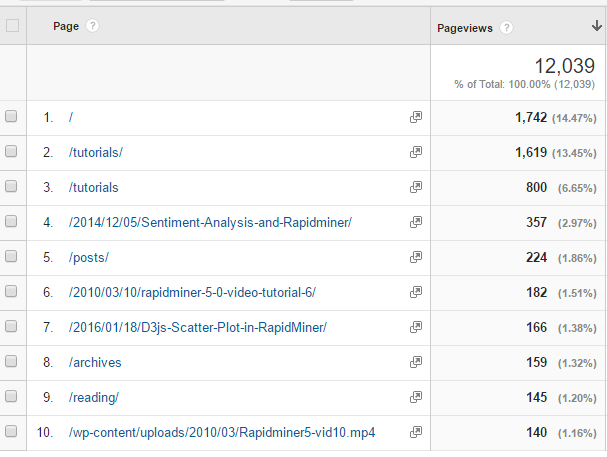
Since I’m now spending my time on the RapidMiner Community and won’t be posting Tutorials here anymore, I expect this blog to die a very slow and painful death.
Unless I step in and stop it.
How? By rebuilding this blog and remaining relevant.
I’m starting a multi part series on how to rebuild a blog, gather metrics, and measure success. I’ll use the revenues I generate from Google Adsense and various conversion rates to guage how well I’m doing. Of course, I’ll add a dash of Data Science in there as well using my favorite tool: RapidMiner.
Where my readers are coming from
Here’s a map right out Google Analytics showing where the majority of my readers have come from in the first half of 2016.
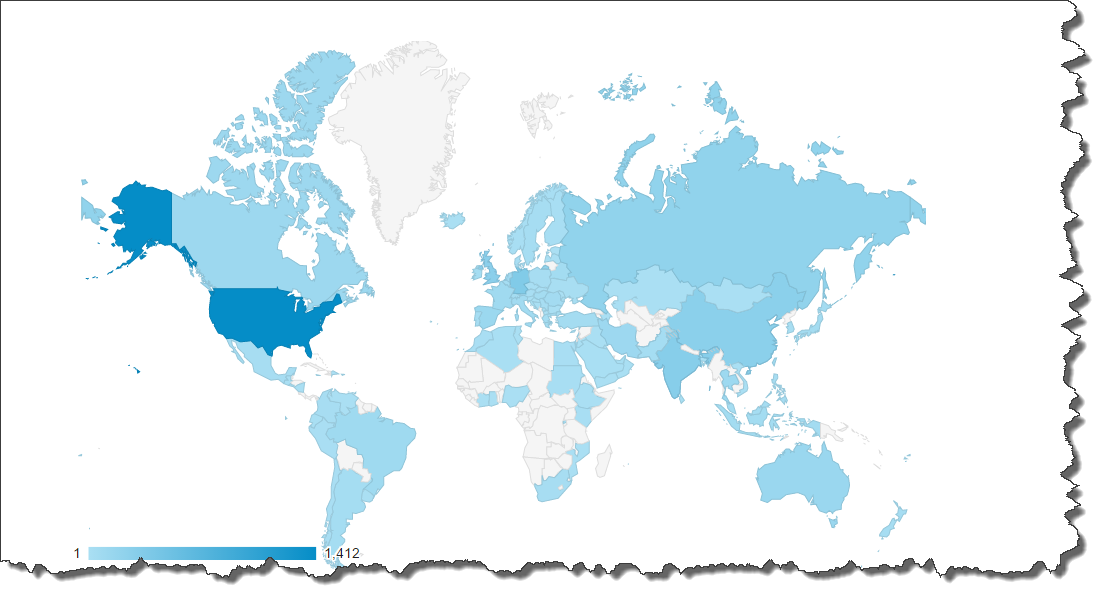
Mobile Traffic
I got curious as I dug through my Google Analytics data. How are my readers interacting with my site? Is it mobile or is it desktop. Once again, the results aren’t surprising. 11.88% visit my site from mobile devices but the overwhelming majority (88.12%) is a desktop or tablet.


Smartphones are becoming ubiquitous and if my kids and nephews are an indicator, the desktop will go away one day. With technologies like AirDrop and Chromecast, do we really need a desktop to consume content? In the future, probably not. I think that mobile friendly blogging is a must in the near future here so this as part of my blog rebuilding, I will focus on making this site more “pro-mobile.”
New vs Returning Readers
The following chart is truly interesting. The rate of returning mobile users is the same as the rate of returning desktop/tablet users.
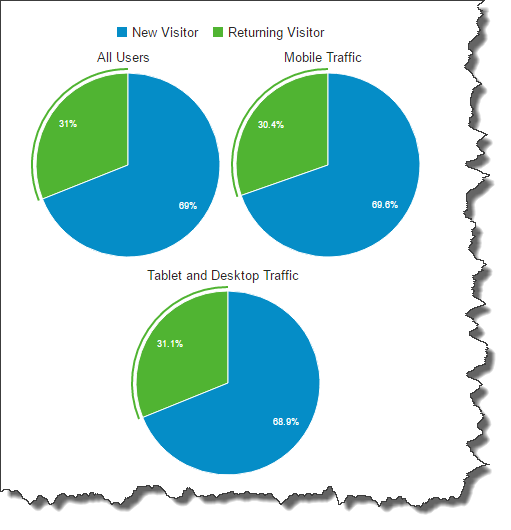
My new SEO strategy is starting to pay off and I owe it all to tweaking the Blot.IM templates. I spent time changing the templates for better metadata and tag handling, and it appears to be working. The biggest results is that my bounce rate has dropped massively.
August 2015 vs August 2016
For this post I wanted to evaluate August 2016’s traffic to August 2015 traffic. The screen shot below shows some improvement but also some more work that needs to be done.
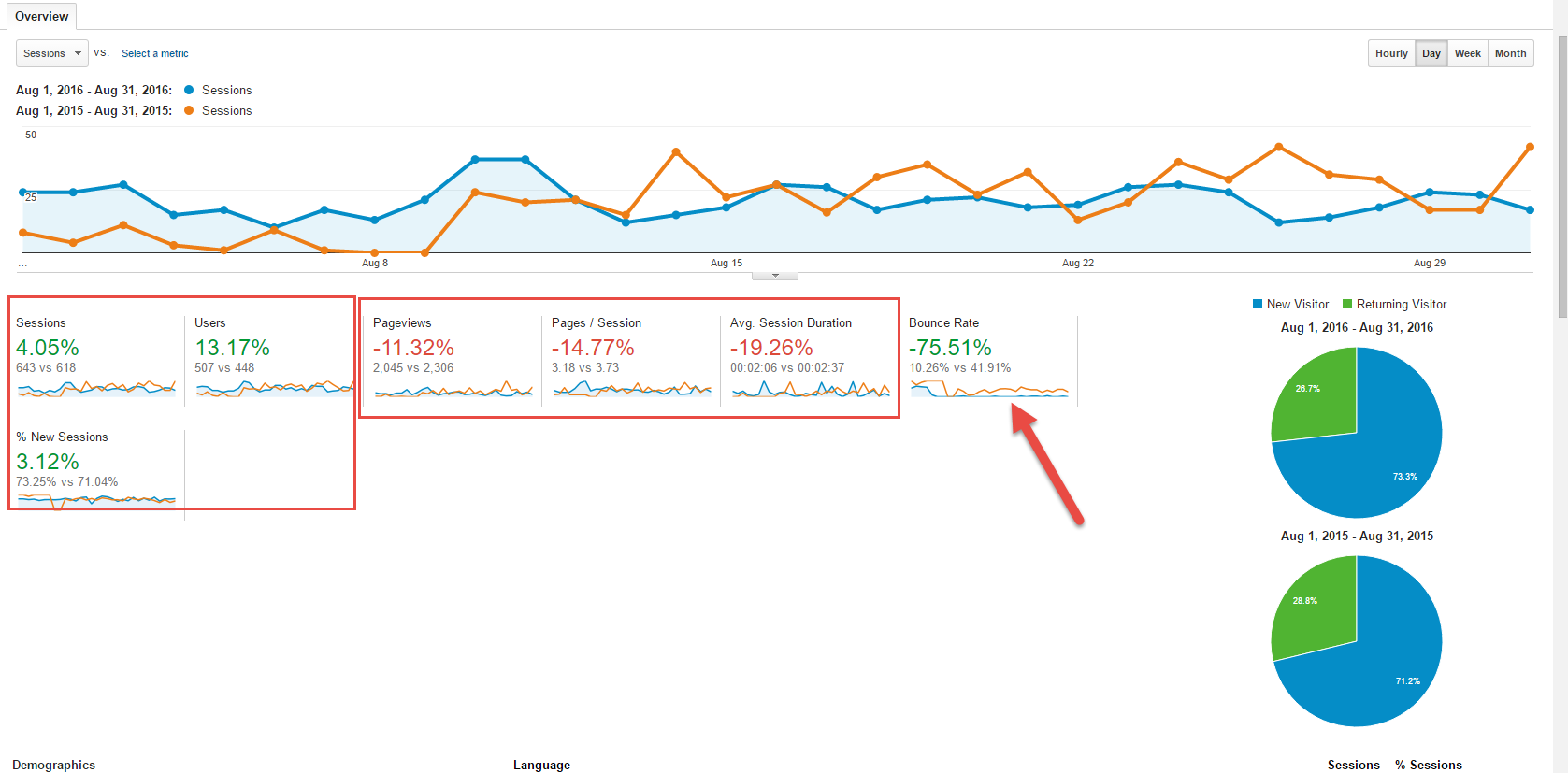
The Good News
The good news is that I have more sessions, users and % new sessions than last year. Coupled with a really great drop in bounce rate, I think this was a big win for me and this blog.
The Bad News
The bad news is that my page views, pages per session and average session duration is down. However, it’s still NOT that bad considering that visitors look at 3 pages per session and spend an average of over 2 minutes on my site. That’s pretty high engagement!
2016 Goals
I created a total of 7 goals:
- Sticky Time, how many readers stay on the site for 5 minutes or more
- Read more that 1 post, self explanatory
- Click on SEO tag, how many readers click on https://www.neuralmarkettrends.com/tags/seo
- Click on Tutorials tag, how many readers click on https://www.neuralmarkettrends.com/tags/tutorials
- Click on All tags, this one is bunk so ignore it.
- Click on RSS feed, how many users click on the RSS feed link
- Use the search, how many readers use the search box
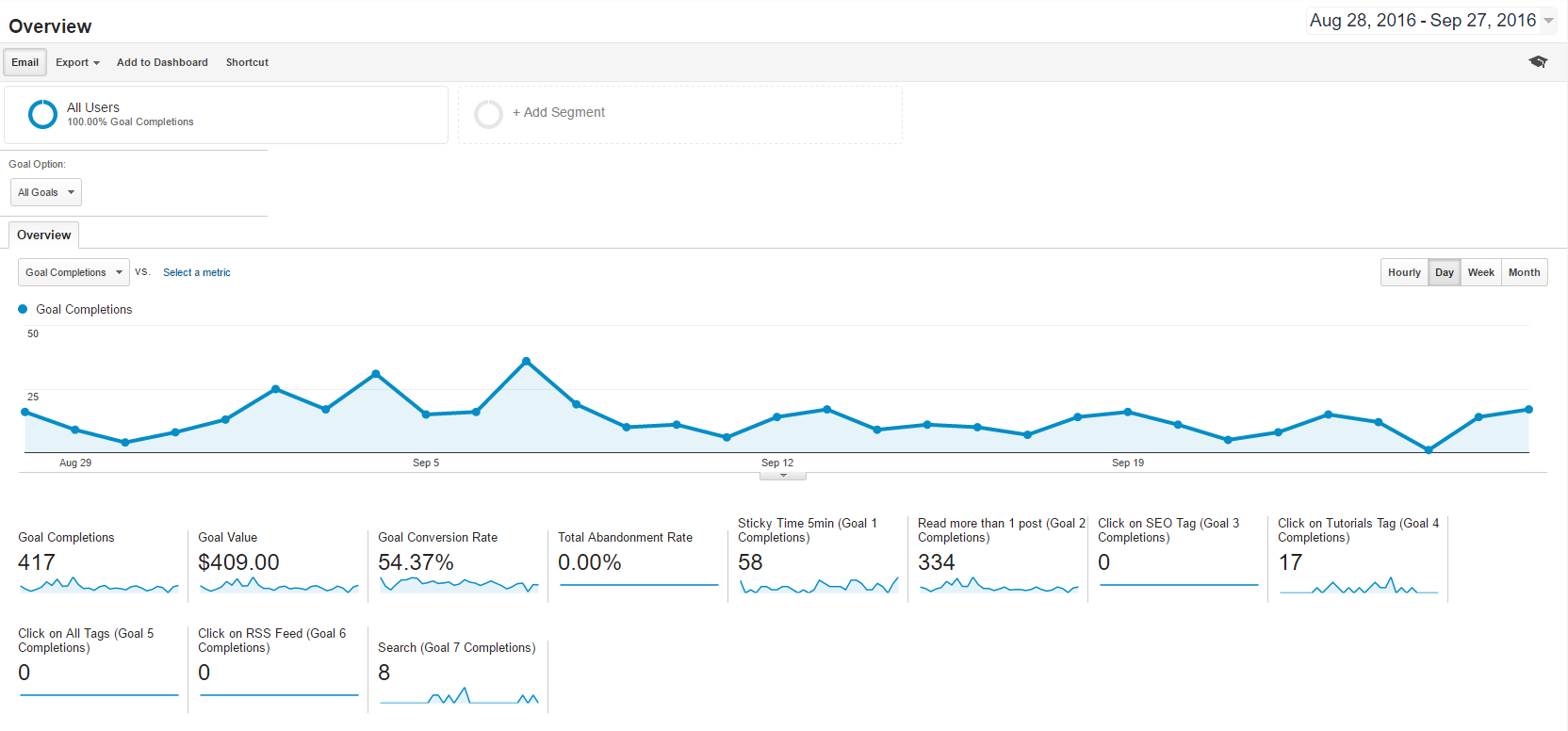
The chart shows some interesting results. I have any amazing amount of sticky time and people read more than 1 post. This makes me think I should abandon Google Ads and sell some space on my own.
On top of this, there’s some activity in the use of the search box and people do click on the Tutorial tags. No one cares about the SEO and RSS.
Alerts
Although this will be deprecated soon my Google, I do like to look at this. It’s nice to see that all things are green and there is some activity in new users and page sessions.

Overall, things are improving here but the lack of tag click - except the Tutorials tag - leads me to guess that:
- People don’t care about those tags, or
- People don’t know enough about navigating to those tags.
Update in 2020
Google made some changes in 2020 that caused this blog to drop in rankings. That was just the icing on the cake, I had some other serious structural problems that caused this blog to slip away in oblivion. I switched CMS system many times and all the changes in permalinks and internal structure pushed me very low in the search results. Blogs that I followed and have remained on the same CMS system have seen a steady growth. So to stem the losses I finally settled on my blogging system, Hugo. While it’s not as dynamic as WordPress, it fits my style. Whatever can get help get your butt in a chair is a good style to adopt.
Since I titled my blog “Neural Market Trends” it might be time to look for new emerging trends and get off this one.
There’s been some changes in the general trend for my particular topic, machine learning and data science. Now there’s 1000’s of blogs on Medium and elsewhere. They have ton’s of tutorials that are way more advanced than I ever could’ve made or had the time to do so. Since I titled my blog “Neural Market Trends” it might be time to look for new emerging trends and get off this one.
As I wrote in my above introduction, I’ve made some structural changes to this blog and it’s starting to pay off. Yes, my numbers now are the same as they were in 2016 and I consider that a win. Why? Because in April 2020 they dropped to almost zero. In order to reinvent myself (yet again) with this blog I made some tough decisions.
- I removed blog posts that were like Tweets. Low word count posts were put to archive
- I collapsed multiple posts into one massive post (like this one. Detailed and posts of 5,000 to 10,000 words make it to the top of the Google Search Results, typically
- I cleaned up bad links in posts and fixed a lot of 404 issues
- I tweaked my Hugo template for SEO optimization (i.e. responsive images, keywords, etc)
The chances are that I won’t be renewing my RapidMiner Tutorials and because I will be taking this blog in a new direction
These four things have brought a growing number of Organic traffic to my site that’s been lacking for years. My new aggregated RapidMiner Tutorial page is starting to rank at number 18 in search results! That’s great news because I used to be in the top 5 search results!
Granted tweaking my old content to rank higher smells like ‘gamification’ and it is to degree. What do my old tutorials have to really offer my readers UNLESS I refresh them with new content.
The chances are that I won’t be renewing my RapidMiner Tutorials and because I will be taking this blog in a new direction. Let me explain.
Blogging is a wonderful way to really express yourself and help others. Making a living from it is a welcome secondary result but it should never be the reason for you to start a blog.
I blogged myself to new career and its been an awesome ride so far, I love what I do and I can’t imagine not doing it for the rest of my life. That said, there’s a lot that knowledge and experience I can share with my readers that I think they would find helpful.
So yes, you can (re)build your blog traffic. You just have to keep the structure of your CMS intact and write valuable evergreen content. That’s really it.